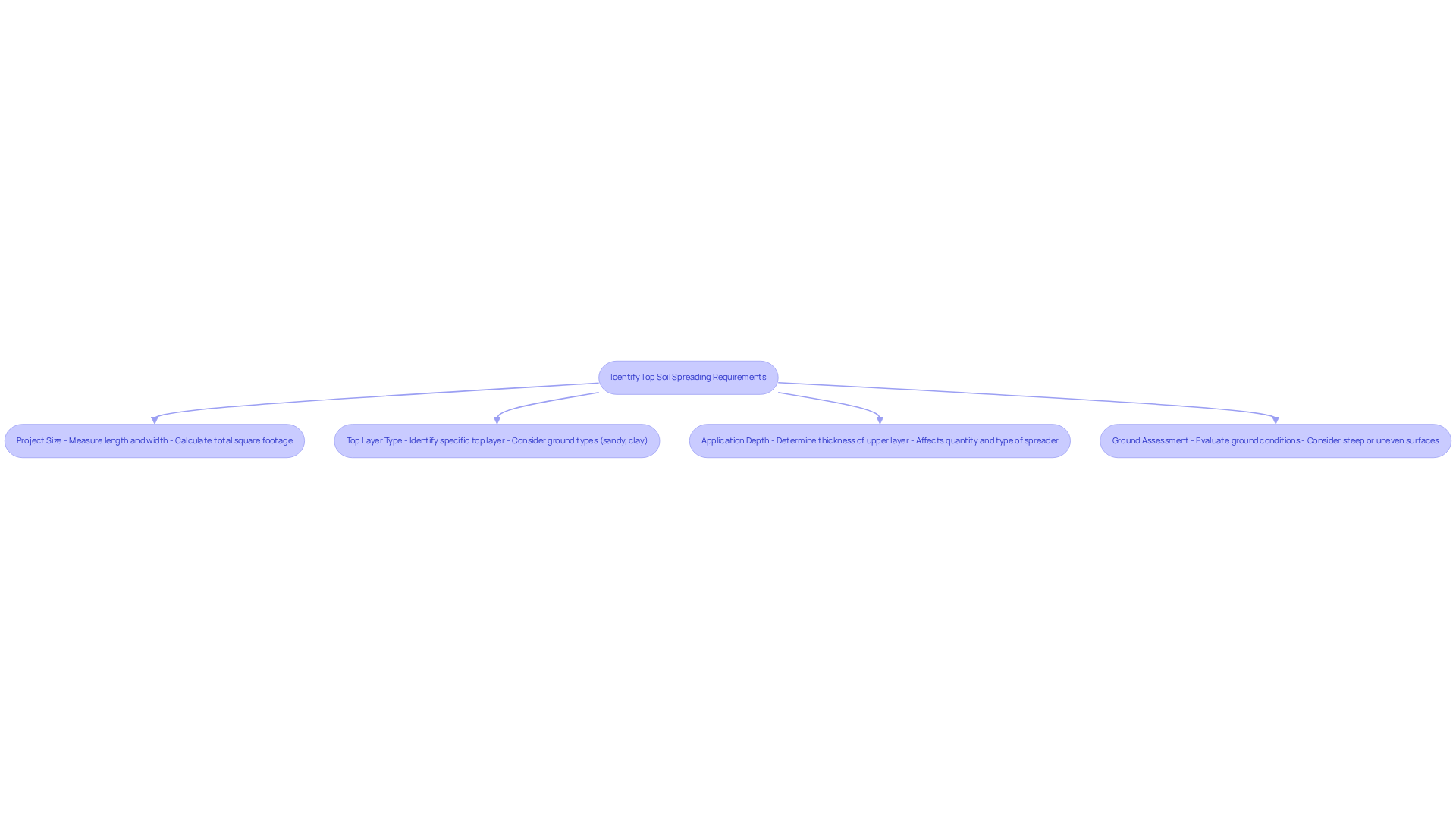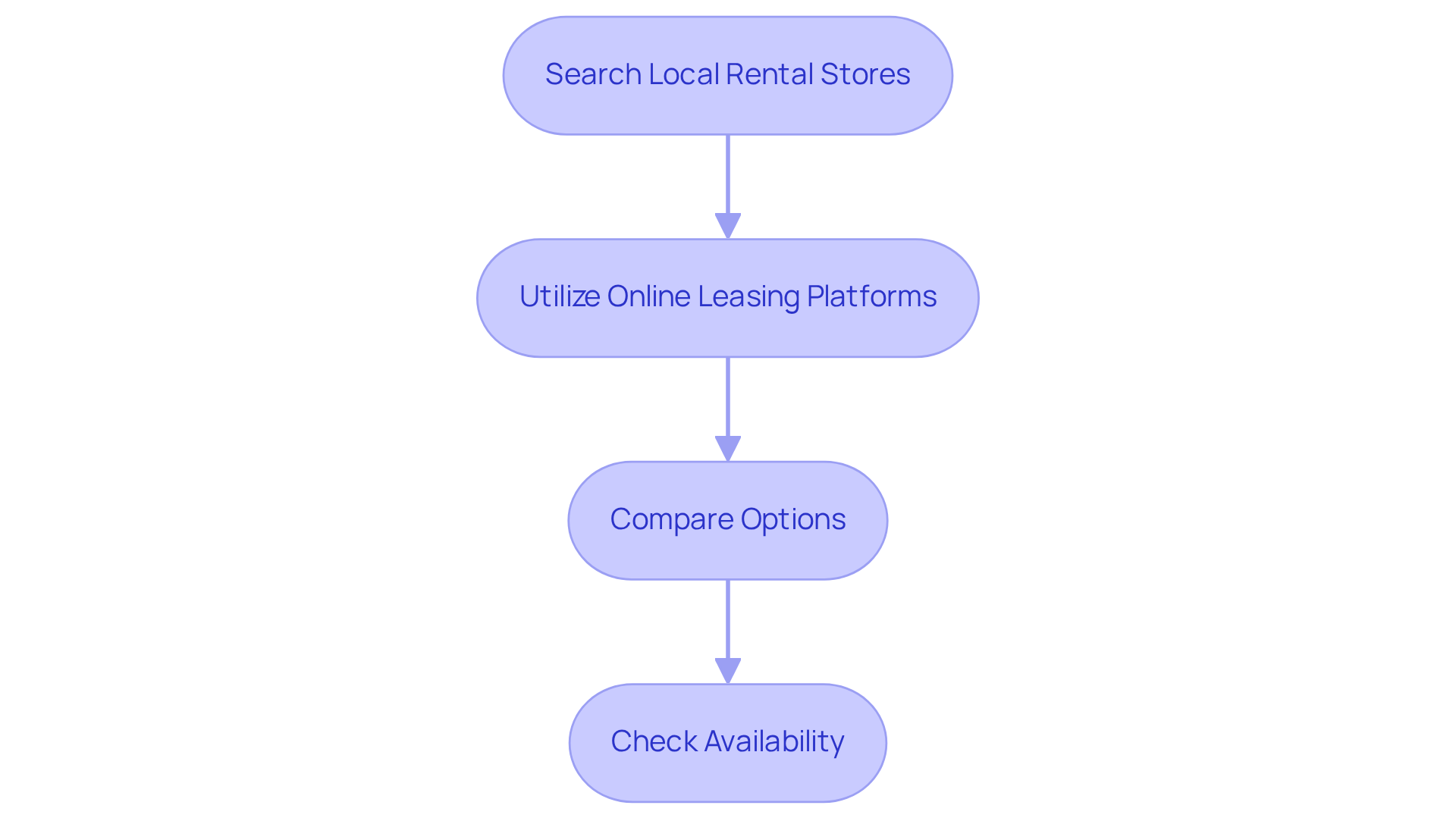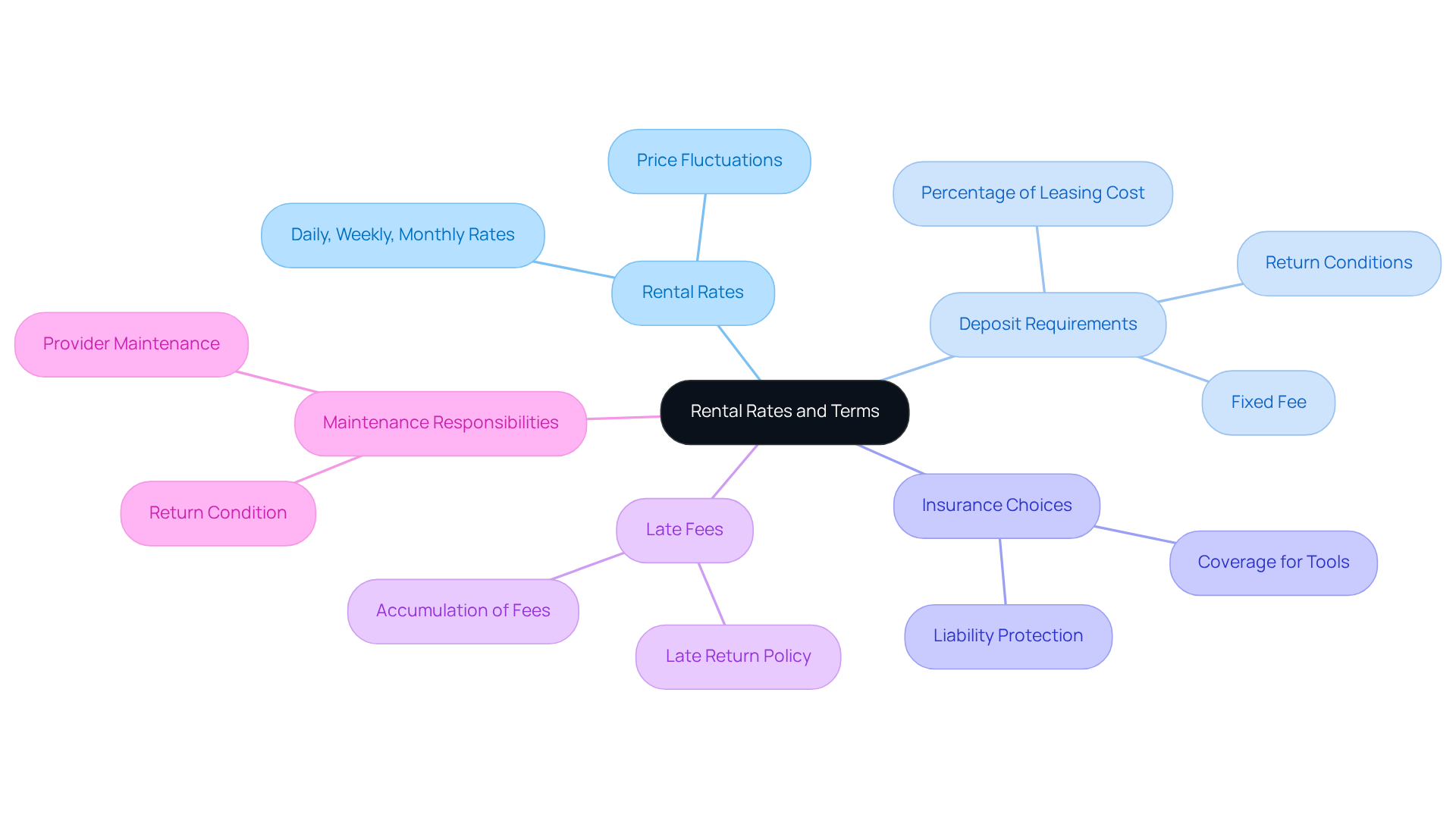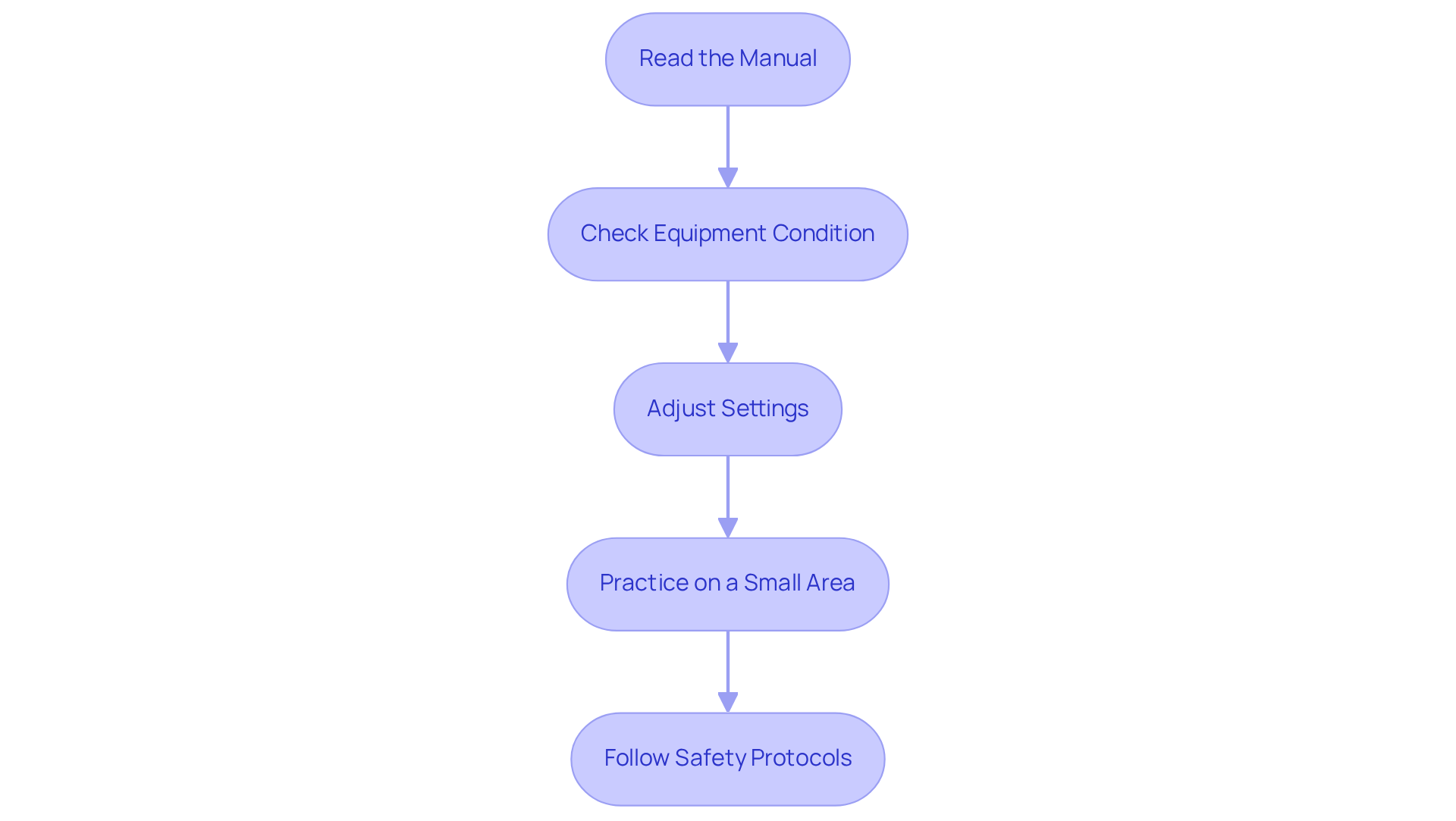Overview
This article serves as an authoritative guide for individuals seeking to rent a top soil spreader. It emphasizes the critical importance of:
- Evaluating project needs
- Exploring rental options
- Understanding rental terms
By detailing factors such as project size, soil type, and application depth, it aids users in selecting the appropriate equipment. Furthermore, it advises on rental rates, maintenance responsibilities, and operational tips, ensuring effective and safe usage. This comprehensive approach not only informs but also empowers users to make confident decisions.
Key Highlights:
- Evaluate project needs by determining project size, top layer type, application depth, and ground conditions to select the right top soil spreader.
- Explore local equipment rental stores and online platforms for top soil spreader rentals to find suitable options.
- Compare rental options based on client feedback, equipment condition, and leasing terms to make an informed decision.
- Understand rental rates, deposit requirements, insurance options, late fees, and maintenance responsibilities to avoid unexpected costs.
- Follow operational tips such as reading the manual, checking equipment condition, adjusting settings, practising on a small area, and adhering to safety protocols for effective use.
Introduction
Navigating the realm of top soil spreader rentals can indeed present challenges, particularly with the myriad of factors that influence equipment choice for any given project. By understanding specific requirements—such as project size, soil type, and application depth—one can significantly enhance the efficiency and success of soil spreading endeavors.
With a diverse array of local and online rental options at your disposal, how can you ensure the selection of the ideal spreader while steering clear of unexpected costs? This guide delves into the essentials of renting a top soil spreader, equipping you with the knowledge necessary to make informed decisions and achieve optimal results.
Identify Your Top Soil Spreading Requirements
Before considering a top soil spreader rental near me, it's essential to evaluate your project needs thoroughly. Start by considering the following factors:
- Project Size: Accurately determine the area that requires top soil application. Measure both the length and width of the space to calculate the total square footage effectively.
- Top Layer Type: Identify the specific type of top layer you will be using. Different spreaders are designed to perform optimally with particular ground types, such as sandy or clay terrains.
- Application Depth: Clearly determine how thick you want the upper layer to be, as this directly affects the quantity of earth required and the type of spreader that will be most appropriate for your project.
- Ground Assessment: Evaluate the ground where the material will be distributed. Steep or uneven surfaces may necessitate specialized equipment to ensure effective application.
By distinctly defining these requirements, you position yourself to select the most suitable top soil spreader rental near me for your project. This strategic approach leads to enhanced results and improved efficiency.

Explore Local and Online Rental Options
Once you have identified your primary spreading needs, it is essential to explore leasing options effectively. Here’s how to proceed:
-
Local Equipment Rental Stores: Begin your search by looking for equipment rental companies in your vicinity, such as EZ Equipment Rental in Irving, TX. By visiting their websites or contacting them directly, you can inquire specifically about top soil spreader rental near me.
-
Online Leasing Platforms: In addition, leverage online platforms that specialize in equipment leasing. Websites like Home Depot Leasing or dedicated hire services offer a wider selection, ensuring you find the right equipment to meet your project demands.
-
Compare Options: After gathering potential leasing sources, create a comprehensive list to compare their offerings. Pay attention to client feedback, the condition of the equipment, and the terms of leasing to make an informed decision.
-
Check Availability: Lastly, confirm that the equipment you require is available for your intended usage duration. It is advisable to book in advance, particularly during peak seasons, to secure your equipment without delays.
By examining both local and online options, you can uncover the best top soil spreader rental near me that is tailored to your project requirements.

Understand Rental Rates and Terms
Before finalizing your rental, it’s essential to grasp the rates and terms involved. Understanding these factors ensures a seamless leasing experience and helps you avoid unexpected costs.
Rental Rates: Inquire about the daily, weekly, or monthly rental rates for a top soil spreader rental near me. Prices can fluctuate considerably based on the category of apparatus and the length of the lease. Knowing these rates upfront will help you make informed decisions and budget effectively.
-
Deposit Requirements: Numerous leasing companies necessitate a deposit, which can vary from a percentage of the leasing cost to a fixed fee. Familiarize yourself with the amount required and the conditions for its return, as this can significantly impact your budget. According to industry standards, deposits generally range from 10% to 30% of the leasing cost, depending on the apparatus and leasing duration.
-
Insurance Choices: Verify if the leasing company provides coverage for the tools. This coverage can protect you from liability in case of damage or accidents, providing peace of mind during your project. As industry specialists point out, possessing insurance can greatly lessen financial risks linked to tool leasing.
-
Late Fees: Understand the late return policy, as late fees can accumulate quickly. Ensure you return the equipment on time to avoid unexpected costs. Clear communication with the leasing provider regarding these terms is crucial to prevent misunderstandings.
-
Maintenance Responsibilities: Clarify who is accountable for maintenance during the lease period. Some companies may require you to return the device in the same condition it was rented, while others may manage maintenance themselves. Understanding these responsibilities can help you avoid additional charges.
By grasping these elements, including the adaptability of leasing contracts to modify inventory for changing project requirements, you can prevent surprises and guarantee a seamless leasing experience.

Utilize Tips for Effective Equipment Operation
To ensure the effective operation of your rented top soil spreader, adhere to the following essential tips:
- Read the Manual: Before utilizing the equipment, thoroughly read the operator’s manual. Familiarize yourself with the controls and safety features to ensure a smooth operation.
- Check Equipment Condition: Inspect the spreader for any visible damage or wear prior to use. It is crucial to report any issues to the rental company immediately to avoid complications.
- Adjust Settings: Configure the spreader according to the type of soil and the desired application depth. Adjust the spread rate to guarantee even distribution across the area.
- Practice on a Small Area: If you are unfamiliar with the tools, it is advisable to practice on a small, inconspicuous area first. This will allow you to get a feel for the equipment’s operation.
- Follow Safety Protocols: Always wear appropriate safety gear, including gloves and goggles. Ensure that bystanders maintain a safe distance while you operate the equipment.
By following these operational tips, you can enhance both efficiency and safety while using the top soil spreader, ultimately leading to successful project completion.

Conclusion
When embarking on a top soil spreading project, understanding the nuances of selecting and renting the right equipment is crucial for achieving optimal results. By carefully assessing project requirements, exploring both local and online rental options, and comprehending rental terms, individuals can ensure they are well-prepared for a successful undertaking.
The rental process involves several key aspects that must not be overlooked:
- Defining specific project needs is essential, as it allows for a targeted approach when comparing various rental sources.
- Being aware of associated costs and responsibilities can help avoid unexpected expenses.
- Effective operation tips can enhance safety and efficiency during the use of the top soil spreader, ensuring that the equipment serves its purpose effectively.
Ultimately, taking the time to research and plan for a top soil spreader rental can significantly impact the outcome of landscaping projects. By leveraging available resources and adhering to best practices, individuals can streamline their project execution and foster a deeper understanding of equipment usage and maintenance. This proactive approach not only enhances the quality of work but also contributes to a more satisfying and successful project experience. Engage with us today to ensure your top soil spreading project is executed flawlessly.
Frequently Asked Questions
What should I consider before renting a top soil spreader?
Before renting a top soil spreader, you should evaluate your project needs by considering the project size, top layer type, application depth, and ground assessment.
How do I determine the project size for top soil application?
To determine the project size, measure both the length and width of the area that requires top soil application to calculate the total square footage effectively.
Why is it important to identify the type of top layer?
Identifying the specific type of top layer is important because different spreaders are designed to perform optimally with particular ground types, such as sandy or clay terrains.
How does application depth affect my project?
The application depth affects the quantity of earth required and the type of spreader that will be most appropriate for your project.
What should I assess about the ground before spreading top soil?
You should evaluate the ground where the material will be distributed, as steep or uneven surfaces may necessitate specialized equipment for effective application.
How can defining my requirements help with the top soil spreader rental?
By distinctly defining your requirements, you can select the most suitable top soil spreader rental for your project, leading to enhanced results and improved efficiency.




